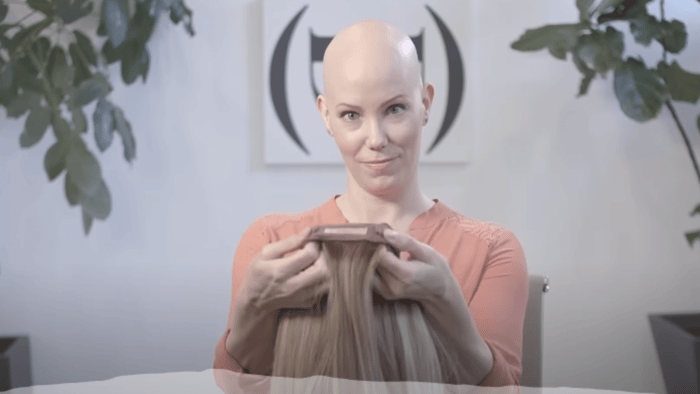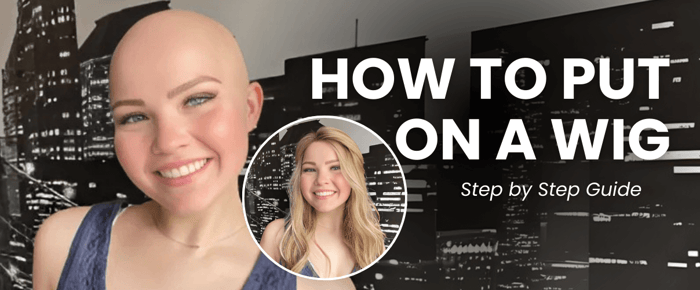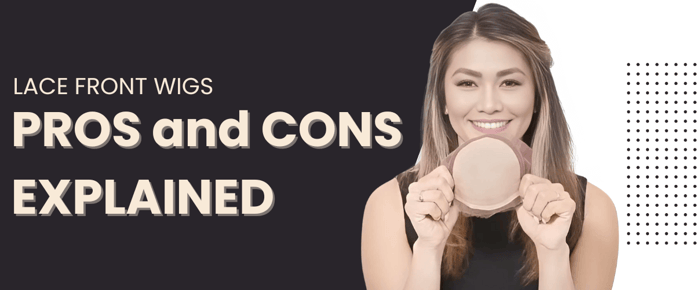Wearing a wig can feel both exciting and a little overwhelming at first. Learning how to put on a wig is an important step—it helps your piece feel comfortable, look natural, and truly become part of your everyday life. Whether this is your very first time trying a wig or you’re looking for a refresher, this guide is here to walk you through the process with clarity and care.
From preparing your natural hair and scalp to choosing the right cap, securing your wig, and blending it seamlessly, we’ll cover every step. Along the way, you’ll also find tips tailored for different hair lengths and textures, plus styling and maintenance advice to keep your wig looking beautiful. Most of all, this is about helping you feel supported and confident as you explore what feels right for you.
Table of Contents
- Understanding Wigs: Types, Caps, and Choosing What’s Right for You
- Preparing Your Natural Hair and Scalp
- How to Put on a Wig: The Basic Method
- How to Put on a Lace Front Wig: Detailed Guide
- How to Put on a Dimples Remy Wig
- Video Tutorial on How to Put on a Wig
- How to Secure a Wig
- Adjusting and Blending for a Natural Look
- Styling Your Wig: Tips for Personalization
- Wig Care and Maintenance for Longevity
- Final Thoughts
- FAQs
Understanding Wigs: Types, Caps, and Choosing What’s Right for You
Wigs come in different types, primarily synthetic and human hair. Synthetic wigs offer affordability and ease of maintenance. They retain their style even after washing, making them ideal for those seeking convenience.
Human hair wigs, on the other hand, provide a natural look and feel. They can be styled like your natural hair, offering versatility and a realistic appearance. Although they require more care, many find their authenticity worth the investment.
Choosing the right wig cap is vital for comfort and security. Wig caps act as a foundation, helping the wig fit snugly against your scalp. There are several types to consider:
- Standard cap: Offers basic construction with a closed-weft design.
- Monofilament cap: Provides the appearance of natural hair growth from the scalp.
- Lace front cap: Creates a seamless, natural hairline for more styling options.
When selecting a wig, consider your lifestyle and personal needs. If you lead an active life, a synthetic wig might suit you better. For those who prioritize a natural look, human hair might be the way to go.
Understanding your face shape and skin tone also plays a role in your decision. The right wig can highlight your features and complement your complexion. Don't hesitate to seek professional guidance for a color and style that suits you.
In the end, choosing the right wig is about finding what makes you feel your best. With the right type and cap, you can enjoy a wig that fits both your head and your life with confidence.
Preparing Your Natural Hair and Scalp
Proper preparation of your natural hair and scalp ensures your wig feels comfortable and secure throughout the day. Start by cleansing your scalp to remove any oil or residue. A clean base helps the wig cap adhere properly, preventing slippage.
Moisturizing is also essential, especially if you plan to wear your wig for long hours. Use a gentle, non-greasy moisturizer suitable for your scalp. This step helps prevent dryness and irritation.
Styling your natural hair under a wig depends on your hair length. Flatten your hair as much as possible to avoid lumps or bumps under the wig. For additional security, hair gel or spray can help keep shorter hair in place.
Consider wearing a wig cap to keep your natural hair tidy and in place. Wig caps provide a protective barrier between your hair and the wig. Choose a breathable material for comfort.
Here's a checklist for preparing your hair and scalp:
- Cleanse your scalp
- Apply moisturizer
- Secure natural hair
- Wear a wig cap
***With Dimples Hera wigs, you can skip the wig cap. Their PerFit® hand-tied wig caps are designed with a silky soft layer that provides an intuitive and comfortable fit, mimicking the feel of your own skin. These caps are ideal for those with sensitive skin seeking a barely-there-wear experience. For Short Hair
Short hair can be easily prepped for a wig with the right approach. Begin by combing your hair back, ensuring it's as flat as possible. This minimizes any bumps once the wig is on.
You might want to use a styling gel or cream for extra hold. Applying this product can help keep your hair in place under the wig cap. Consider this quick checklist:
- Comb hair flat
- Apply styling gel
Keeping your short hair well-prepared ensures a smoother, more natural wig fit. It also contributes to your overall comfort throughout the day.
For Long Hair
Long hair requires a bit more attention before wearing a wig. Start by parting your hair down the middle and braiding each section. Secure the ends with small, unobtrusive ties.
Next, wrap the braids around your head, securing them with bobby pins. This keeps your long hair flat and manageable under the wig cap.
Here's a simple checklist:
- Braid into two sections
- Wrap and pin braids
Successfully securing long hair ensures your wig sits comfortably and looks natural. This method prevents any unwanted bumps and creates a smooth base for the wig.
For Little or No Hair
For those with little or no hair, preparation involves ensuring a clean and moisturized scalp. Gently exfoliate to remove any dry skin, then apply a soothing moisturizer to maintain comfort.
Using a wig cap is optional but beneficial. It provides an extra layer of comfort and helps the wig stay in place securely. Consider this checklist:
- Cleanse and exfoliate
- Apply moisturizer
With little or no hair, preparation is straightforward yet important. These simple steps ensure a comfortable fit and help protect the scalp against irritation.
How to Put on a Wig: The Basic Method
Here are some steps to guide you through the process of how to put on a wig:
Step 1: Begin by holding the wig at the sides, near the ear tabs. This helps maintain control and allows for precise placement. Make sure you’re working in a well-lit space with a mirror.
Step 2: Next, position the front of the wig at your natural hairline. Tilt your head slightly forward and pull the wig over your head. Adjust the wig so it sits comfortably and naturally on top of the cap.
Step 3: The ear tabs should align with your ears. This ensures the wig is centered. Gently tweak the tabs until you achieve a balanced look. Proper alignment is key to achieving a natural appearance.
Step 4: To secure the wig, adjust the internal straps if your wig has them. These straps help tailor the fit to your head, preventing slippage. Never underestimate the importance of a snug, secure fit for peace of mind.
Here’s a quick checklist to follow:
- Hold the wig at the ear tabs
- Position the front at your hairline
- Align ear tabs with ears
- Adjust internal straps
- Ensure a snug fit
Once your wig is secured, take a moment in front of the mirror to check the fit. Adjust gently until it feels comfortable and looks natural. These small refinements—whether it’s shifting the part, smoothing the hairline, or tucking in stray hairs—can make all the difference in how seamless and confident your wig feels throughout the day.
How to Put on a Lace Front Wig: Detailed Guide
Putting on a lace front wig is a bit different from applying a standard wig. It involves some extra steps, but the result is a highly natural look that blends seamlessly with your scalp. Here’s how to get it right:
Step 1: Start by preparing your skin. Cleanse your forehead with a gentle cleanser and dry it thoroughly. Avoid oils or lotions which can affect the adhesive strength.
Step 2: Once your skin is prepped, you’ll need to trim the excess lace. Carefully cut as close to the hairline as possible without cutting the hair itself. Use sharp scissors for a clean edge.
Step 3: Before applying the wig, do a quick fitting. Place it on your head and align the front lace with your natural hairline. Check in the mirror to ensure it looks right.
Step 4: Now, it’s time to secure the wig. Apply a thin line of adhesive or wig tape along your hairline. Allow it to become tacky—this usually takes about 30 seconds to one minute.
Step 5: Carefully position the lace front wig on your head. Starting from the center, press down gently along the hairline, working outward. This gradual approach helps avoid misalignment.
For extra hold, many find it helpful to wrap a scarf around their head for about ten minutes. This ensures the adhesive sets effectively and provides a natural appearance.
Here's a handy checklist for reference:
- Prepare your skin
- Trim excess lace carefully
- Align with natural hairline
- Apply adhesive or tape
- Press and secure gradually
From time to time, check the edges of your lace to be sure they’re secure and blending naturally with your skin. A smooth transition is key to achieving a realistic look. Once you’re happy with the placement, gently comb through the wig to integrate any of your own hair and refine the style. With a little practice, putting on your lace front wig will start to feel effortless—helping you step into your day feeling comfortable and assured.
***One important thing to remember when wearing a Lace Front Wig is to avoid pulling on the lace. The lace is very delicate and can tear easily if you tug on it or use it to adjust the wig. Instead, you should always use the ear tabs or the back label to move or reposition the wig. This way, you can protect your wig and enjoy its natural beauty for a long time.How to Put on a Dimples Remy Wig
Putting on a wig can be a hassle, but not with Dimples Hera Wigs.
This wig is designed for everyday wear as it makes your life easier by eliminating most of the steps involved in putting on a wig.
Dimples Wigs make wearing a wig easy and comfortable. You don't need to spend a lot of time preparing your hair or securing the wig. You can simply follow these steps on how to put on a wig and style it as you wish.
Step 1

First, look at the inside of the wig and locate the front and back labels.
The front label should be near the lace that covers the forehead, and the back label should be near the nape of the neck.
Step 2

Next, hold the wig by the front and back labels and gently place it over your head.
Make sure that the ear tabs are aligned with your ears and that the wig is not too tight or too loose.
You can adjust the size of the elastic band by using the hooks or Velcro at the back of the wig.
Step 3

Then, carefully position the front lace until it reaches your natural hairline.
The lace should blend in with your skin and create a realistic appearance of hair growth.
If you don't have a natural hairline or a reference point, you can use your fingers to measure where to place the wig.
A general rule is to leave about four fingers' width of space between your eyebrows and the edge of the wig for a realistic finish.
Step 4

Finally, you can style your wig as you normally would with your own hair.
You can use a comb, a wig brush, or your fingers to arrange the hair in any way you like.
You can also use heat tools, such as a curling iron or a flat iron, to create different looks.
However, be careful not to damage the lace or the hair fibers with too much heat or friction.
Video Tutorial on How to Put on a Wig
How to Secure a Wig
Securing your wig is vital for a comfortable and confident wear. It ensures your wig stays in place throughout the day, giving you peace of mind.
First, let’s discuss clips. Sewn into the wig cap, clips attach to your natural hair, providing a secure hold. They are ideal for those with some natural hair and offer a quick, non-adhesive option.
Combs, similar to clips, also anchor the wig to your hair. They are gentle but effective and work well for light support. Simply slide them into your hair at strategic points around the wig.
For those needing stronger security, adhesives might be the way to go. Adhesive options include wig glue and tape. These products are perfect for lace front wigs and those with minimal hair, offering robust hold for all-day wear.
It’s crucial to test adhesives on your skin beforehand to prevent allergic reactions. Remember, different wigs may require different securing methods based on their design and your comfort.
Consider this overview:
- Clips: Quick attachment for natural hair
- Combs: Light, gentle support
- Adhesives: Stronghold for lace front or minimal hair
📌 If you are looking for an extra level of security and convenience for your wig, you may want to consider Dimples wigs. These wigs feature a hand-tied cap with silicone strips that provide a secure grip for your wig without any adhesive products or damaging tapes.
The silicone strips create a suction effect that prevents the wig from slipping or shifting on your head. You can confidently wear these wigs without worrying about them coming off. By following these methods—or by choosing a wig with thoughtful features like our Dimples Hera collection—you can feel confident your wig will stay comfortably in place throughout the day. That way, you can simply enjoy wearing your hair with ease, style, and peace of mind.
Adjusting and Blending for a Natural Look
Achieving a natural appearance with your wig involves some thoughtful adjustments and blending techniques. The goal is to make the wig look like your own hair.
Start by aligning the wig with your natural hairline. This is crucial for creating a seamless and believable hairline. Spend some extra time here to perfect the positioning.
Next, focus on your wig's parting. Use a tail comb to adjust the part until it looks just right. If your wig allows, tweak the part to match your natural look or preferred style.
To blend the wig with any visible natural hair, use a small amount of styling cream or gel. Work this into the hair around the edges. This step helps merge the textures and reduces any contrast between wig and natural hair.
Here's a quick checklist for a flawless blend:
- Align wig with your hairline
- Adjust parting to preference
- Use styling products for blending
Incorporating these steps will enhance the natural look of your wig, ensuring comfort and confidence every time you wear it.
Styling Your Wig: Tips for Personalization
Styling a wig offers a unique opportunity to showcase your personality. With some creativity, you can make your wig truly yours.
Start by considering a haircut or trim. If your wig allows, a slight change in length or layers can provide a fresh look. Consult a professional stylist to avoid damaging your wig.
Color is another fantastic area to explore. Adding lowlights or highlights can bring depth and vibrancy to your look. Just ensure that any coloring is compatible with your wig type. Human hair wigs can often withstand more styling than synthetic ones.
Experiment with textures, such as curls or waves, using heat tools. Always use heat protectant products to maintain your wig’s integrity. However, remember that synthetic wigs generally have specific heat constraints.
Here are some styling ideas to consider:
- Try a new part direction
- Use accessories like headbands or clips
- Explore braiding styles
Personalizing your wig enhances comfort and confidence, making it a joyful part of your style journey.
Wig Care and Maintenance for Longevity
Caring for your wig properly is crucial for extending its life and keeping it looking fresh. Regular maintenance also ensures comfort and longevity.
Start with washing your wig every 8-12 wears. Use a mild shampoo and cool water. Always handle with care to avoid tangling. After washing, gently pat dry with a towel.
Conditioning is key to keeping fibers soft and manageable. Apply a suitable conditioner and let it sit for a few minutes. Rinse thoroughly with cool water. This process replenishes moisture and adds shine.
Storage is another important aspect of wig care. Always store on a wig stand away from direct sunlight to maintain its shape. Cover with a satin or silk scarf for added protection.
Keep these tips in mind for wig maintenance:
- Brush with a wide-tooth comb
- Use wig-specific products
- Avoid sleeping or showering with your wig on
By following these tips, you'll enjoy a wig that looks stunning and lasts longer, making every day a good hair day.
Final Thoughts
Learning how to put on a wig is more than just a step-by-step process—it’s an act of self-care and expression. With the right preparation, application, and care, your wig can feel as natural and effortless as your own hair. Over time, what may seem daunting at first becomes second nature, opening the door to ease, comfort, and confidence in your everyday life.
At Dimples, we’ve spent decades designing wigs that blend seamlessly, feel comfortable, and honor every stage of your journey. Whether you’re exploring your first wig or refining your technique, remember that you’re not alone—support, guidance, and beautiful options are always here for you.
📌 Ready to take the next step? Book a free consultation with our experts or explore our Remy Wig Collection to discover the piece that feels like it was made just for you.
Hera 23" | Remy Human Hair Lace Front Wig (Hand-Tied)

$4,700.00
Meet the longest length in our Hera wig collection: 23 inches of Remy human hair, handcrafted for life, movement, and goddess-tier energy. Hair Type: 100% Remy Human Hair Hair Length: 23"" crown to tips. Front: 18"", Side: 18"", Back: 18"",… read more
Hera 19" | Remy Human Hair Lace Front Wig (Hand-Tied)

$3,299.00
Hera 19"" is made for bold beauty and everyday wear. With flowing Remy human hair and a seamless lace front, this hand-tied wig gives you freedom to move, part, and style — all without compromise. Hair Type: Remy Human Hair… read more
Hera 15" | Remy Human Hair Lace Front Wig (Hand-Tied)

$2,999.00
Hera 15" is a medium-length Remy human hair lace front wig designed to deliver full coverage, natural movement, and all-day comfort. Ideal for women experiencing hair loss, thinning, or alopecia, it blends luxury craftsmanship with a breathable, lightweight fit. The… read more
Hera 8" | Remy Human Hair Lace Front Wig (Hand-Tied)

$2,099.00
Hera 8" is a short Remy human hair lace front wig designed for full coverage with a soft, realistic look and barely-there feel. Perfect for women experiencing hair loss, thinning, or alopecia, it blends luxury craftsmanship with everyday comfort. The… read more
FAQs
Are the steps for putting on a wig the same for all types of wigs?
The steps of putting on a wig are very similar for most types of wigs, but there are some slight variations depending on the type of wig cap and the style of the wig.
For example, lace front wigs require more care and attention than other types of wigs, as the lace is very delicate and needs to be trimmed and secured properly. Lace wigs are popular because they create a natural-looking hairline that allows you to wear the hair away from your face.
Lace Front Wigs
Lace front wigs have a thin strip of lace along the front edge of the wig cap that mimics the look of your natural hairline.
The lace is designed to sit flat and flush against your forehead, creating a seamless transition between the wig and your skin.
However, not all lace front wigs are the same.
Some lace front wigs come pre-cut and ready to wear, while others have excess lace that needs to be cut before wearing.
Dimples Hera Lace Front Wig stands out from other lace front wigs with its unique features that make it easier to wear and more natural-looking.
Uncut vs. Pre-Cut
Some lace front wigs have excess lace that extends beyond the hairline.
This lace needs to be carefully cut before wearing the wig, following the shape of your natural hairline.
Cutting the lace can be tricky and intimidating, as you don't want to cut too much or too little or damage the wig in the process.
If you are not confident or experienced in cutting lace, you may want to opt for a pre-cut lace front wig instead.
Pre-cut lace front wigs have the excess lace already trimmed for you, saving you time and hassle.
Dimples lace front wigs come pre-cut and ready to wear, so you don't have to worry about cutting the lace yourself.
What is the difference between a Hand Tied wig vs. Machine Made wig?
Wigs can be made using different methods of production: hand-tied or machine-made. Each method has its own advantages and disadvantages, depending on your preferences and needs.
Hand Tied Wigs
Hand-tied wigs are made by hand-knotting individual strands of hair onto a thin mesh cap.
This creates a very natural look and feels, as the hair can move freely and be parted in any direction.
Hand-tied wigs are also more breathable and comfortable than machine-made wigs, as they conform to your head shape and do not have any bulky seams or wefts.
Dimples Hera Wigs are 100% hand-tied, giving you the highest quality and most realistic wig possible.
Machine Made Wigs
Machine-made wigs are made by sewing hair onto strips of fabric called wefts, which are then attached to a cap.
This method is faster and cheaper than hand tying, but it also results in a less natural look and feel.
Machine-made wigs tend to have more volume and density than hand-tied wigs, which can make them look unnatural or heavy.
Machine-made wigs also have limited styling options, as they can only be parted in certain directions due to the way the wefts are sewn onto the cap.
Why are hand-tied wigs more expensive?
Hand-tied wigs are more expensive than machine-made wigs for several reasons:
The labor involved in making a hand-tied wig is much more intensive and time-consuming than making a machine-made wig. It can take up to six times longer to make a hand-tied wig than a machine-made wig.
The skill required to make a hand-tied wig is also higher than making a machine-made wig. Hand-tied workers need years of training and experience to master their craft. Many brands do not offer hand-tied wigs because they cannot find enough qualified workers.
The hair used for hand-tied wigs is also more costly than the hair used for machine-made wigs. Hand-tied wigs need longer hair strands to account for the return hairs, which are the hairs that are knotted through the cap and then folded back over.
What is the difference between Synthetic Hair, Human Hair & Remy Hair?
Synthetic Hair, Human Hair, and Remy Hair are different types of hair fibers that are used to make wigs. Each type of wig hair has its own advantages and disadvantages, depending on your preferences and budget.
Synthetic Hair
Synthetic hair is made from man-made fibers that mimic the look and feel of natural hair.
Synthetic hair wigs are easy to care for, as they do not require styling or washing. They also retain their shape and color well, even in humid conditions.
However, synthetic hair wigs cannot be exposed to heat, such as curling irons or blow dryers, as they can melt or damage the fibers.
Synthetic hair wigs also tend to have a shorter lifespan than human hair wigs, as they can become frizzy or dull over time.
Human Hair
Human Hair is made from real hair that is collected from donors.
Human hair wigs offer the most natural look and feel, as they can be styled, colored, and washed just like your own real hair.
They also have more movement and shine than synthetic hair wigs.
However, human hair wigs are more expensive than synthetic hair wigs, as they require more processing and care.
Human hair wigs also need to be styled regularly, as they can lose their shape or curl after washing.
Human hair wigs can also be affected by environmental factors, such as humidity or sun exposure, which can alter their color or texture.
Remy Hair
Remy Hair is a type of human hair that is considered to be the highest quality and most desirable.
Remy hair is collected from donors in a way that preserves the natural direction of the cuticles, which are the outer layer of the hair shaft.
This means that all the cuticles are aligned in the same direction, which reduces tangling and matting.
Remy hair also undergoes minimal processing, which preserves its natural strength and softness.
Remy hair wigs are more expensive than other types of human hair wigs, but they also last longer and look more natural.
How often should I wash my wig?
Typically, washing your wig every 8-10 wears is recommended. This keeps it fresh without over-washing. Adjust based on lifestyle and environmental factors.
Can I use heat-styling tools on my wig?
This depends on the type of wig. Synthetic wigs may not handle high heat well, whereas human hair wigs do.
How long can a wig last?
With proper care, a quality wig can last several months to over a year. Longevity depends on material, care, and frequency of wear.





